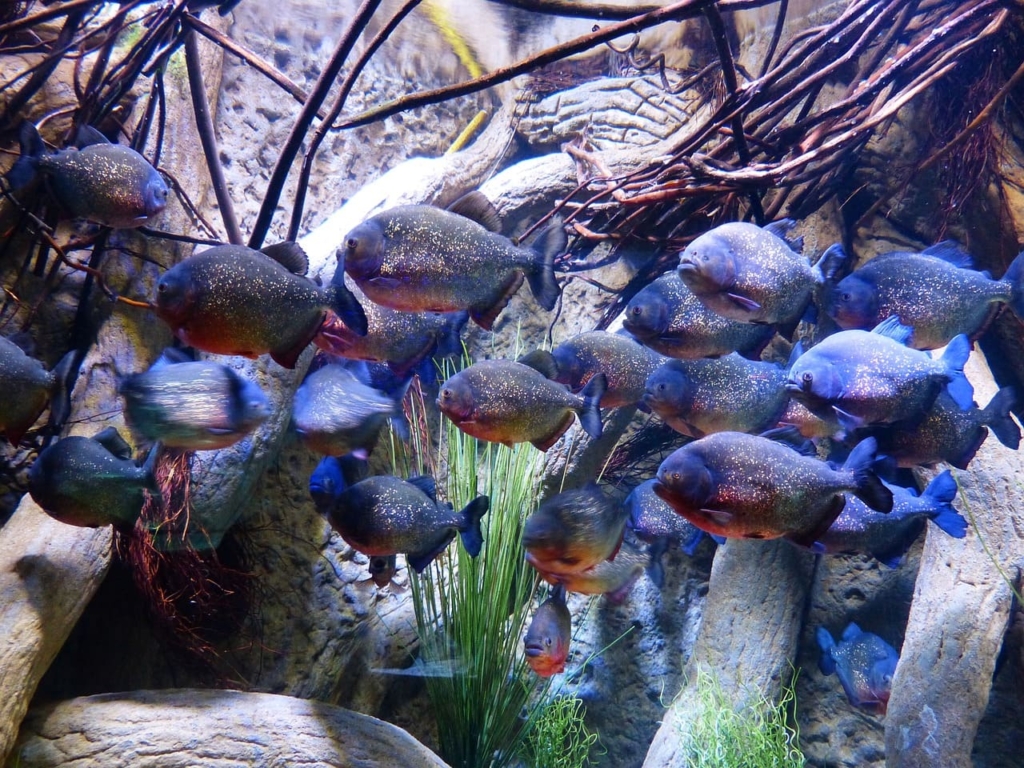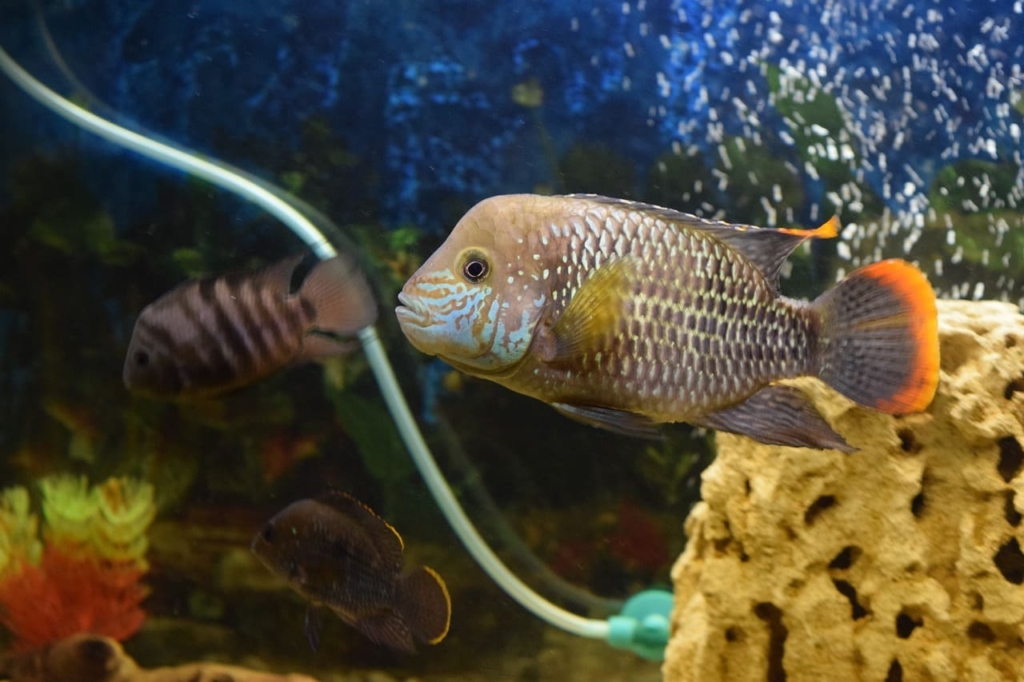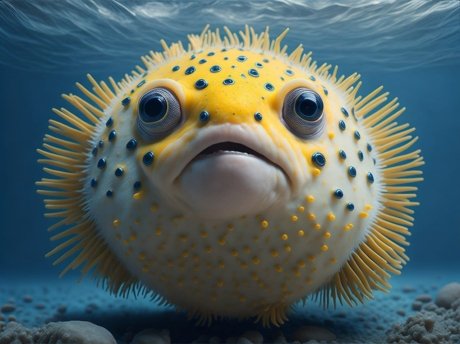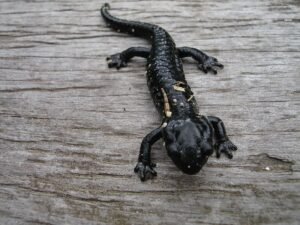Piranha Fish | Information, 10 Types, Facts, Are They Dangerous?
Do you want to dive into the captivating world of piranha fish? Known for their fearsome reputation and sharp teeth, piranhas have long intrigued both nature enthusiasts and moviegoers alike. In this comprehensive guide, we will unravel the mysteries surrounding these fierce freshwater predators. From their diverse species and ecological role to their care requirements and intriguing behaviours, we’ll provide you with all the essential insights into the world of piranha fish.
Piranha Fish
Piranhas, the formidable freshwater fish native to South America, have captivated human imagination for ages. Known for their sharp teeth and aggressive feeding habits, they are often portrayed as vicious killers. However, in reality, these fascinating creatures have a much more diverse and intriguing nature.
The Different Species of Piranhas: In the vast family of Characidae, various species of piranhas exist. Among the well-known ones are the Red-Bellied Piranha, the Black Piranha, and the White Piranha Fish. Each species has distinct traits that set them apart.

Physical Characteristics of Piranhas: Piranhas typically boast small to medium-sized bodies, ranging from 5 to 14 inches in length. Their streamlined shape allows swift movement in water, and their most striking feature is their triangular, interlocking teeth, which deliver a powerful bite force.
Natural Habitat and Distribution: Piranha Fishes call the rivers and lakes of South America home, primarily in the Amazon Basin and the Orinoco Basin. Their adaptability has led to a wide distribution in countries like Brazil, Peru, and Venezuela.
Feeding Habits and Diet: Piranhas are opportunistic carnivores, preferring a diet of fish, insects, and other aquatic creatures. Contrary to popular belief, they aren’t relentless human-hunters.
Misconceptions and Myths about Piranhas: Piranhas have been sensationalized in movies and media, often depicted as merciless killers. However, attacks on humans are rare, and keeping them as pets is not advisable due to their specialized needs.
Piranhas and Ecosystems: Piranhas play a vital role in their ecosystems, regulating smaller fish populations and controlling aquatic vegetation, maintaining a balance in the food chain.
Piranhas and Human Interaction: While piranhas pose little threat to humans, occasional attacks can occur, especially when food is scarce. Conservation efforts are essential to protect their habitats and avoid conflicts with local communities.
The Fascinating Behavior of Piranhas: Piranha Fishes exhibit intriguing group dynamics and communication through vocalizations and body language. During breeding, they display remarkable parental care.
Popular Piranha Aquarium Species: Despite their fearsome reputation, some enthusiasts attempt to keep piranhas as pets. However, this requires thorough research and adherence to regulations.
Piranha Conservation and Threats: PiranhaFishes face threats such as deforestation, habitat destruction, and overfishing. Preserving their natural environment is crucial to their survival.
Piranhas in Science and Research: Piranhas have also piqued scientific interest, with studies exploring their unique physiology and ecological impact.
Cultural Significance of Piranhas: In South American indigenous cultures, piranhas hold cultural significance, featuring in traditional stories and playing a part in the local economy.
The Role of Piranhas in Popular Culture: PiranhaFishes have left a mark on popular culture through movies, books, and other media, solidifying their reputation as fierce predators.
Danger Piranha Fish
Piranhas have earned a fearsome reputation as dangerous predators with razor-sharp teeth. While they are indeed carnivorous and can be aggressive, they are not mindless killers. Hollywood exaggerations have perpetuated misconceptions about their threat to humans. In reality, piranha attacks on humans are rare, and they play a vital role in their ecosystems as mid-level predators. Understanding the truth about piranhaFishes can help dispel the myths and foster a greater appreciation for these fascinating creatures.

Piranha Aquarium Fish
For aquarium hobbyists seeking an extraordinary addition to their tanks, piranhas can be an intriguing choice. Their striking appearance and captivating behaviour make them stand out among other aquarium fish. However, keeping piranhaFishes as pets requires careful consideration and adherence to specialized care guidelines. With the right approach, enthusiasts can enjoy the fascinating presence of these unique aquatic creatures in their home aquariums.
Big Piranha Fish
When picturing a piranha Fish, one may envision a massive, monstrous fish capable of devouring anything in its path. While there are large species of piranhas, not all of them are gigantic. Understanding the diverse sizes of piranha Fishes can help dispel common myths about their proportions and contribute to a more accurate understanding of these intriguing creatures.
Piranha Fish In Amazon River
The Amazon River, teeming with life, is home to various species of piranha fish. These carnivorous creatures play a vital role in the river’s ecosystem, regulating fish populations and controlling aquatic vegetation. Understanding their natural habitat and behaviour in the wild can offer valuable insights into the delicate balance of life in the Amazon.
Pet Piranha Fish
Keeping a piranha as a pet can be an exciting prospect for some enthusiasts. However, it comes with significant responsibilities and challenges. From providing a suitable environment to ensuring proper feeding and care, owning a pet piranha Fish requires dedication and knowledge. Prospective pet owners must weigh the risks and rewards to determine if they can meet the unique needs of these captivating creatures.
Types of Piranha Fish
There are several types of piranha fish, each with its own unique characteristics and distribution. Some of the most well-known types include:
1. Red-Bellied Piranha (Pygocentrus nattereri):
This is one of the most common and popular species of piranha Fish. It is easily identifiable by its red or orange belly, and it is found in various regions of South America, including the Amazon Basin.
2. Black Piranha (Serrasalmus rhombeus):
The black piranha Fish is known for its powerful bite and strong jaw muscles. It has a dark colouration and is found in rivers and lakes across the Amazon and Orinoco Basins.
3. White Piranha (Serrasalmus rhombeus):
The white piranha Fish is named for its silvery-white colouration. It is also found in the Amazon Basin and other South American water bodies. This species is less aggressive compared to some other piranha types.
4. Pygmy Piranha (Pygocentrus piraya):
As the name suggests, this species is much smaller than other piranha Fishes. It is found in the rivers and streams of the Amazon Basin and is known for its sharp teeth and aggressive behaviour.
5. San Francisco Piranha (Pygocentrus piraya):
This species is native to the San Francisco River in Brazil. It is similar to the pygmy piranha in appearance and behaviour.
6. Redeye Piranha (Serrasalmus rhombeus):
The redeye piranha Fish gets its name from the red colouration around its eyes. It is found in the Amazon and Orinoco Basins and is known for its predatory nature.
7. Gold Piranha (Serrasalmus elongatus):
This species is distinguishable by its gold or yellowish colouration. It is found in the rivers and lakes of Brazil and is a popular choice for aquariums.
8. Manuel’s Piranha (Serrasalmus manueli):
This rare species of piranha Fish is found in the Rio Orinoco in Venezuela. It is known for its distinctive colouration and aggressive behaviour.
9. Spotted Piranha (Serrasalmus spilopleura):
The spotted piranha has unique dark spots on its body. It inhabits various rivers and streams throughout South America.
10. Orinoco Piranha (Pygocentrus cariba):
This species is native to the Orinoco River and its tributaries. It is known for its striking red colouration and sharp teeth.
The Different Species of Piranhas
Piranhas belong to the family Characidae and come in various species. Among the most well-known are the Red-Bellied Piranha Fish, the Black Piranha, and the White Piranha. Each species has unique characteristics that set them apart from one another.

Physical Characteristics of Piranhas
Piranha Fishes are generally small to medium-sized fish, ranging from 5 to 14 inches in length. They have sleek, torpedo-shaped bodies that are well-adapted to swift movement in the water. Their most striking feature is their triangular teeth, which interlock to deliver a powerful bite force.
Natural Habitat and Distribution
Piranhas are native to the rivers and lakes of South America, primarily found in the Amazon Basin and the Orinoco Basin. They have also been spotted in other countries like Brazil, Peru, and Venezuela. Their ability to adapt to different aquatic environments has contributed to their wide distribution.
Feeding Habits and Diet
Contrary to popular belief, piranha Fishes are not mindless killers. They are opportunistic carnivores, and their diet primarily consists of fish, insects, and smaller aquatic creatures. When food is scarce, they may resort to scavenging.
Misconceptions and Myths about Piranhas
Over the years, Hollywood movies and sensationalized stories have portrayed piranhas as bloodthirsty monsters. In reality, they are not a significant threat to humans, and attacks on humans are rare. Moreover, keeping piranha Fishes as pets is highly discouraged due to their specialized needs and aggressive behaviour.
Piranhas and Ecosystems
Piranha Fishes play a crucial role in their ecosystems by regulating the population of smaller fish and controlling aquatic vegetation. As mid-level predators, they help maintain the balance of the food chain in their habitats.

Piranhas and Human Interaction
While piranha Fishes rarely pose a threat to humans, there have been instances of attacks, particularly when their natural food sources are scarce. Conservation efforts are vital to ensure their habitats remain intact and prevent conflict with local communities.
Popular Piranha Aquarium Species
Due to their fearsome reputation, some people are drawn to keeping piranha Fish as pets. However, it requires careful consideration and adherence to regulations since not all piranha species are suitable for aquarium life.
Piranha Conservation and Threats
Piranhas face several threats to their survival, including deforestation, habitat destruction, and overfishing. Efforts to protect their natural environment and regulate fishing practices are essential to their preservation.
Piranhas in Science and Research
Beyond their portrayal in media, piranha Fishes have garnered interest in the scientific community. Biomedical studies have explored their unique physiological features, and ecological research has shed light on their role in aquatic ecosystems.
Cultural Significance of Piranhas
For indigenous communities in South America, piranha Fishes hold cultural significance. They feature in traditional stories and beliefs and play a part in the local economy through fishing and tourism.
The Role of Piranhas in Popular Culture
Piranha Fishes have left their mark on popular culture through movies, books, and other media. Their fierce image has been immortalized in art and literature, perpetuating their reputation as formidable predators.
History of Piranha Fish
Piranha Fishes have a fascinating history that dates back to ancient times. These ferocious freshwater fish have been part of South American cultures for centuries. Today, scientific research continues to unravel the mysteries of their evolution and behaviour, shedding light on these captivating creatures.
Appearance of Piranha Fish

With their streamlined bodies and sharp teeth, piranha Fishes have a fearsome appearance. Their sleek form allows them to swiftly navigate through water, while their razor-sharp teeth are essential for their carnivorous diet. Understanding their physical characteristics can help us appreciate the uniqueness of these intriguing fish.
Are Piranhas Saltwater Fish
Contrary to popular belief, piranha Fishes are not saltwater fish. They are exclusively found in freshwater environments, primarily inhabiting the rivers and lakes of South America. Their adaptability to freshwater habitats has contributed to their widespread distribution.
Are Piranhas Freshwater Fish
Yes, piranhas are freshwater fish. They thrive in the nutrient-rich waters of South American rivers and lakes. While they are known for their preference for freshwater environments, some species may tolerate brackish water conditions for a limited time.
Can You Eat A Piranha Fish
While piranha Fishes have a reputation as fearsome predators, they are also consumed as food in certain regions. In South America, they are part of local cuisine, and their white flesh is considered a delicacy. However, caution is necessary due to the risk of parasites and toxins.
Fish Like Piranha
Several fish species share similarities with piranha Fishes in terms of appearance and behaviour. Some of these include pacus, which are closely related to piranhas but have different dental structures, and barracudas, known for their sharp teeth and aggressive hunting behaviour.
Temperament of Piranha Fish
Piranhas are often depicted as aggressive and bloodthirsty in movies and media. While they are carnivorous and territorial, their behaviour is more complex and nuanced than the sensationalized portrayals. Understanding their temperament helps dispel myths and foster a more accurate perception of these fish.

The Fascinating Behavior of Piranhas
Piranha Fishes are social creatures, forming groups known as shoals. Within these shoals, they exhibit intricate social behaviours and communication through vocalizations and body postures. Studying their behaviour provides valuable insights into their complex group dynamics.
Piranha Fish Bite
The piranha fish bite is one of the most feared aspects of these creatures. Their powerful jaws and sharp teeth allow them to deliver devastating bites to their prey. Understanding their bite force helps us appreciate the impressive predatory capabilities of piranha Fishes.
Piranha Fish Teeth
Piranhas’ teeth are specialized for their carnivorous diet. They have a triangular shape and are tightly interlocked, enabling them to puncture and shear through flesh efficiently. Their dental structure is a fascinating example of nature’s engineering at work.
7 Popular Piranha Fish Movies
Piranha fish have made a splash in the world of cinema, captivating audiences with their fearsome reputation and thrilling stories. From horror to comedy, these carnivorous creatures have starred in various movies, leaving a lasting impression on moviegoers worldwide. Here are some of the most popular piranha fish movies that have taken the big screen by storm:
1. Piranha (1978):
Directed by Joe Dante, this cult classic horror-comedy film follows a group of unsuspecting tourists who become prey to a swarm of mutant piranhas. The movie perfectly blends scares with humour, making it a memorable watch.
2. Piranha (2010):
A modern remake of the 1978 film, this version, directed by Alexandre Aja, amps up the terror with upgraded special effects and intense action sequences. The story revolves around a resort town invaded by prehistoric piranhas during spring break, leading to chaos and carnage.
3. Piranha 3D (2010):
This 3D horror-comedy sequel takes the piranha madness to a whole new level. Directed by Alexandre Aja, the movie features a star-studded cast and delivers over-the-top gore and suspense, making it a guilty pleasure for horror enthusiasts.
4. Piranha 3DD (2012):
A follow-up to Piranha 3D, this sequel takes the terror to a water park. Directed by John Gulager, the movie combines horror with humour and introduces new ways for the piranhas to terrorize their unsuspecting victims.
5. Piranhaconda (2012):
If you’re a fan of B-movie creature features, this SyFy original film is a must-watch. Directed by Jim Wynorski, Piranhaconda is a hybrid monster movie that combines the deadly attributes of piranhas and anacondas, resulting in a creature that spells double trouble for its victims.
6. Mega Piranha (2010):
Directed by Eric Forsberg, this sci-fi disaster film takes the concept of piranhas to the extreme. The movie features giant mutant piranhas wreaking havoc on everything in their path, including boats, helicopters, and even people.
7. Piranha Sharks (2014):
Directed by Leigh Scott, this horror-comedy takes a humorous approach to the piranha concept. In this film, piranha Fishes are genetically modified to have legs and venture onto land, turning into deadly “piranha sharks.”
Facts about Piranha Fish
Facts about Piranha Fish: Unraveling the Mysteries of These Fierce Predators
- Carnivorous Appetite: Piranha Fishes are carnivorous fish, known for their sharp teeth and powerful bite. They primarily feed on fish, insects, crustaceans, and occasionally small mammals or birds that venture into the water.
- South American Natives: Piranhas are native to the rivers and lakes of South America, particularly the Amazon Basin and the Orinoco Basin. They are most commonly found in countries like Brazil, Peru, Venezuela, and Colombia.
- Variety of Species: Over 60 species of piranha Fishes have been identified, belonging to the family Characidae. Some of the well-known species include the Red-Bellied Piranha, Black Piranha, and White Piranha.
- Social Creatures: Piranhas are social animals that often swim in schools or shoals. This group behaviour helps them coordinate hunting, protect against predators, and navigate through their aquatic environment more efficiently.
- Territorial Behavior: Piranha Fishes can be territorial, especially during breeding seasons. They use various displays and vocalizations to assert dominance and establish their territory within their habitat.
- Parental Care: In certain species, piranhas exhibit remarkable parental care. After laying eggs, the parents guard the nest and protect the hatched fry until they are strong enough to fend for themselves.
- Sensory Perception: Piranha Fishes have a keen sense of smell, which helps them detect blood or traces of prey from considerable distances. They also have excellent vision and can detect movement in the water with precision.
- Ecological Role: Despite their fearsome reputation, piranhas play a crucial role in their ecosystems. As mid-level predators, they help regulate the population of smaller fish and control aquatic vegetation, contributing to the balance of the food chain.
- Feeding Frenzy Misconceptions: Piranhas’ feeding behaviour has often been sensationalized in popular culture, depicting them in a feeding frenzy that devours everything in their path. In reality, these frenzies are rare and typically occur when piranha Fishes are in a state of heightened competition for food.
- Conservation Concerns: Some species of piranha Fishes are facing conservation threats due to habitat loss, overfishing, and pollution. Preserving their natural habitats is essential to ensure their survival and maintain the delicate ecological balance of South American water bodies.
Pros and Cons of Piranha Fish
Some Pros and Cons of Piranha Fish:
| Pros of Piranha Fish | Cons of Piranha Fish |
|---|---|
| 1. Efficient Predators: Piranhas are highly effective carnivorous fish with sharp teeth and a powerful bite, contributing to the regulation of prey populations in their ecosystems. | 1. Aggressive Behavior: Piranhas can be aggressive, especially when feeling threatened or during breeding seasons. Their territorial nature can lead to confrontations with other fish in confined spaces. |
| 2. Fascinating Behavior: Piranhas exhibit intriguing social dynamics within their shoals, showcasing group communication and coordinated hunting. | 2. Unsuitable as Pets: Piranhas are not ideal pets for inexperienced owners due to their specific care requirements, territorial nature, and potential risks associated with handling them. |
| 3. Ecological Role: As mid-level predators, piranhas play a vital role in maintaining the balance of aquatic ecosystems by controlling the populations of smaller fish and aquatic vegetation. | 3. Legal Restrictions: Owning piranhas may be subject to legal regulations and restrictions in certain regions due to their potential impact on local habitats and the risk of introducing non-native species. |
| 5. Breeding and Parental Care: Some piranha species display fascinating breeding behaviours and exhibit remarkable parental care, protecting their eggs and fry until they are self-sufficient. | 4. Limited Diet Options: Piranhas requires a diet of live or frozen meat, which can be challenging and expensive to provide consistently. |
| 5. Breeding and Parental Care: Some piranha species display fascinating breeding behaviours and exhibit remarkable parental care, protecting their eggs and fry until they are self-sufficient. | 5. Misunderstood Image: Piranhas are often sensationalized and portrayed inaccurately in popular culture, leading to misconceptions about their threat to humans and other aquatic life. |
| 6. Natural Adaptability: Piranha Fishes have adapted to a wide range of freshwater habitats, allowing them to thrive in diverse environments across South America. | 6. Conservation Concerns: Certain species of piranha Fishes face threats due to habitat destruction, overfishing, and pollution, making their conservation a priority for maintaining biodiversity. |
Care For Piranha Fish
Caring for piranha fish requires careful attention to their specific needs and natural behaviours. Here are some essential aspects to consider when providing optimal care for these fascinating creatures:
- Tank Size and Environment: Piranha Fishes are active swimmers and need spacious tanks to thrive. A minimum tank size of 75 gallons is recommended for a small shoal of piranhas. Provide ample hiding places with rocks, driftwood, and plants to create a stimulating and secure environment.
- Water Quality: Maintaining pristine water quality is crucial for piranhas’ well-being. Regular water changes and appropriate filtration are necessary to keep ammonia and nitrate levels low. Water temperature should be maintained within the range of 72-80°F (22-27°C).
- Diet: Piranhas are carnivorous and require a varied diet of live or frozen meat. Offer them high-quality fish, shrimp, or other meaty options to ensure proper nutrition. Avoid feeding them live feeder fish to prevent the risk of introducing diseases.
- Social Behavior: Piranha Fishes are social fish that thrive in shoals. A group of at least six piranhas is recommended to support their natural social interactions. However, keep in mind that overcrowding can lead to aggression.
- Handling with Caution: Piranha Fishes are known for their powerful bite and territorial behaviour. Avoid handling them directly, as their bites can cause severe injuries. Use a net or other tools when necessary, and wear protective gloves.

Piranha Fish Bite Treament
In the rare event of a piranha fish bite, immediate attention is necessary. Piranha bites can be deep and prone to infection. Here are the steps to take for proper treatment:
- Stop the Bleeding: Apply gentle pressure on the wound with a clean cloth or bandage to stop any bleeding.
- Clean the Wound: Rinse the wound with clean, running water to remove any debris or bacteria. Use mild soap if available.
- Antiseptic Application: Apply an antiseptic solution or ointment to the wound to prevent infection.
- Dress the Wound: Cover the wound with a sterile bandage or dressing to protect it from further contamination.
- Seek Medical Attention: Piranha Fish bites can be serious, and it is advisable to seek medical attention, especially if the wound is deep or shows signs of infection.
Piranha Fish Lifespan
The lifespan of piranha fish can vary depending on factors such as species, environment, and care. In well-maintained aquariums, piranha Fishes can live anywhere from 10 to 15 years or more.
Piranha Fish Video
Conclusion:
In conclusion, piranha fish are captivating creatures with a fascinating history and unique characteristics. They play a crucial role in their ecosystems as efficient predators, helping to maintain the balance of aquatic life. While their fearsome reputation may precede them, understanding the truth behind their behaviour and care needs allows for a more nuanced appreciation of these fierce predators. Properly caring for piranha Fishes in captivity requires dedication and adherence to their specific requirements. Ultimately, responsible ownership and conservation efforts are essential to ensure the survival and appreciation of these intriguing fish for generations to come.
Frequently Asked Questions on Piranha Fish:
-
Are piranhas really as dangerous as they are portrayed in movies?
While piranhas are carnivorous and have sharp teeth, their portrayal in movies is often exaggerated. Piranha Fish attacks on humans are rare, and they are more likely to be scared away than pose a serious threat.
-
Can piranhas be kept as pets in home aquariums?
Keeping piranha Fishes as pets is not advisable for inexperienced owners. They have specific care requirements, aggressive tendencies, and may require permits in some regions due to their potential impact on the environment.
-
What do piranhas eat in captivity?
In captivity, piranhas should be fed a diet of live or frozen meat, such as fish, shrimp, or other meaty options. Feeder fish should be avoided to prevent the risk of diseases.
-
How long do piranhas live in aquariums?
In well-maintained aquariums, piranha Fishes can live anywhere from 10 to 15 years or more with proper care, nutrition, and a suitable environment.
-
Can I keep multiple piranhas together in one tank?
Yes, piranhas are social fish and thrive in groups known as shoals. A minimum group of six piranha Fishes is recommended to support their natural social behaviour.
-
Are piranhas freshwater or saltwater fish?
Piranhas are strictly freshwater fish and are native to the rivers and lakes of South America, particularly in the Amazon Basin and the Orinoco Basin.
-
What is the ecological role of piranhas in their habitats?
Piranha Fishes play a crucial role as mid-level predators in their ecosystems. They help regulate prey populations and control aquatic vegetation, contributing to the balance of the food chain.
-
Can piranhas be bred in home aquariums?
Breeding piranhas in home aquariums can be challenging and requires specific conditions and expertise. It is best left to experienced hobbyists or professionals.
-
How should I handle piranhas in the aquarium?
Piranha Fishes should be handled with caution. Use a net or other tools to avoid direct contact, as their bites can cause severe injuries. Wear protective gloves if necessary.
-
Are there different species of piranha fish?
Yes, there are over 60 known species of piranha Fish, each with its own unique characteristics and distribution within South American water bodies.
Recommended –
Myna Bird | Information, Essay, Price, 6 Types, Food, Care Tips, Health
Munchkin Cat | Breed Information, Price, 10 Facts, Care Tips, Food





























